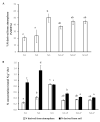Altering Nitrogen Sources Affects Growth Carbon Costs in Vachellia nilotica Growing in Nutrient-Deficient Grassland Soils
- PMID: 34579294
- PMCID: PMC8470937
- DOI: 10.3390/plants10091762
Altering Nitrogen Sources Affects Growth Carbon Costs in Vachellia nilotica Growing in Nutrient-Deficient Grassland Soils
Abstract
Vachellianilotica (L.) Willd. Ex Del. is a multipurpose leguminous tree that is common in grassland and savanna ecosystems in southern and eastern Africa. These ecosystem soils are reported to be acidic and nutrient-limited, specifically with regards to nitrogen (N) and phosphorus (P). The presence of this plant in these terrestrial ecosystems improves soil fertility benefiting the surrounding vegetation due to its ability to fix atmospheric N. This study seeks to understand the N-fixing bacteria symbiosis and physiological adaptations of V. nilotica in these acidic and nutrient-deficient KwaZulu-Natal soils. The soils used for this study were collected from the Ukulinga Grassland Nutrient Experiment located at the Ukulinga research farm of the University of KwaZulu-Natal, Pietermaritzburg, South Africa. Due to long-term soil nutrient addition treatments, these soils offered a diverse nutrient variation for better understanding the effects of acidity and nutrient variation on microbial symbiosis, plant nutrition, and biomass accumulation of V. nilotica. V. nilotica was able to maintain growth by relying on both atmospheric and soil-derived N across all treatments decreasing carbon (C) growth costs. There was an increased reliance on atmospheric-derived N of un-nodulated high N-treated plants. The plants grown in high N + P soils were able to nodulate with various species from the Mesorhizobium genus, which resulted in increased biomass compared to other plants. The results of this study show that V. nilotica can alter N sources to reduce C growth costs. In addition, both nodulating and free-living soil N2 fixing bacteria such as Caulobacter rhizosphaerae, Sphingomonas sp. and Burkholderia contaminans identified in the experimental soils may play an important role under P-deficient conditions.
Keywords: KwaZulu-Natal grassland soils; Mesorhizobium; N-fixing bacteria; P deficiency; Vachellia nilotica.
Conflict of interest statement
We declare no conflict of interest with regard to this study. The funders had no role in the design of the study, in the collection, analyses, or interpretation of data, in the writing of the manuscript, or in the decision to publish the results. The opinions, findings, and conclusions/recommendations expressed in this work are that of the authors, and that NRF accepts no liability whatsoever in this regard.
Figures



References
-
- Smil V. Global population and the nitrogen cycle. Sci. Am. 1997;277:76–81. doi: 10.1038/scientificamerican0797-76. - DOI
-
- Ohyama T. Nitrogen as a major essential element of plants. Nitrogen Assim. Plants. 2010;37:1–17.
-
- Angus J., Bolger T., Kirkegaard J., Peoples M. Nitrogen mineralisation in relation to previous crops and pastures. Soil Res. 2006;44:355–365. doi: 10.1071/SR05138. - DOI
-
- Kumar S., Meena R.S., Datta R., Verma S.K., Yadav G.S., Pradhan G., Molaei A., Rahman G.M., Mashuk H. Carbon and Nitrogen Cycling in Soil. Springer; Berlin, Germany: 2020. Legumes for carbon and nitrogen cycling: An organic approach; pp. 337–375.
Grants and funding
LinkOut - more resources
Full Text Sources

